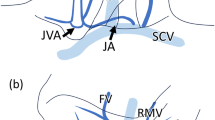Abstract
Aim
Surgical treatment is still the cornerstone in the treatment of breast cancer, a very common neoplasia, particularly affecting the female elderly population. Axillary dissection is crucial in the treatment of some tumours, but variations in axillary vessels anatomy are poorly described in standard anatomy and surgical textbook. We aimed to describe anatomical variations in axillary vessels found in our institutional experience.
Patients and methods
A prospective 3-year study was conducted in our institution from January 2012 to December 2014. Sixty-one consecutive axillary lymph node dissections (ALNDs) were performed in 61 patients who underwent surgery for stage II and III invasive breast cancer. Anatomical details of axillary vascular anatomy and its variations have been evaluated, described and stored in a prospective database.
Results
Sixty-one ALNDs have been performed in the study period. The anatomy of lateral thoracic vein, angular vein and axillary vein was studied and compared with standard anatomical description. Eighteen percentage of venous variations were found out of the 61 dissection performed.
Conclusions
Vascular anatomy of axilla is complex and variable. A better knowledge of all possible variations might be helpful in preventing injuries during ALND.

Similar content being viewed by others
References
Scott Lind D, Souba WW (2005) Breast procedures principles and practice. ACS Surg
O’Rourke MG, Layt CW (1993) Angular vein of the axilla and the anatomy of the subscapular vein important in axillary node dissection. Aust N Z J Surg 63:396–398
Chan CY, Tan M (2003) Spatial relations of the angular vein, an important landmark in axillary nodal dissection. Br J Surg 90:948–949
Rosa M (2015) Advances in the molecular analysis of breast cancer: pathway toward personalized medicine. Cancer Control J Moffitt Cancer Center 22:211–219
Limite G, Di Micco R, Esposito E et al (2014) Acinic cell carcinoma of the breast: review of the literature. Int J Surg 12(Suppl 1):S35–S39
Ger R, Kim D (1988) An aid to axillary dissection. Surg Gynecol Obstet 166:87–88
Ung O, Tan M, Chua B et al (2006) Complete axillary dissection: a technique that still has relevance in contemporary management of breast cancer. ANZ J Surg 76:518–521
Khan A, Chakravorty A, Gui GP (2012) In vivo study of the surgical anatomy of the axilla. Br J Surg 99:871–877
Tan MP, Ung OA (2007) Surgical approach to the angular vein of the axilla: an “inverted” technique of axillary dissection. Breast J 13:220–222
Pu YW, Xing CG, Khan I et al (2012) Fistula plug versus conventional surgical treatment for anal fistulas. A system review and meta-analysis. Saudi Med J 33:962–966
Laporta R, Longo B, Pagnoni M et al (2014) Accidental injury of the latissimus dorsi flap pedicle during axillae dissection: types and reconstruction algorithm. Microsurgery 34:5–9
Dudley HPW (1998) Rob and Smith’s operative surgery: general principles, breast and extracranial endocrine, 4th edn. Hodder Amold, London
Chand M, Swan MC, Horlock N et al (2009) Preservation of the lateral thoracic vein in axillary dissection—its role in breast reconstruction using the DIEP flap. Breast 18:69–70
Soares EW (2014) Anatomical variations of the axilla. SpringerPlus 3:306
Ivanovic N, Granic M, Randelovic T et al (2007) Functional effects of preserving the intercostobrachial nerve and the lateral thoracic vein during axillary dissection in breast cancer conservative surgery. Vojnosanit Pregl 64:195–198
Kutiyanawala MA, Stotter A, Windle R (1998) Anatomical variants during axillary dissection. Br J Surg 85:393–394
Author information
Authors and Affiliations
Corresponding author
Ethics declarations
Conflict of interest
The authors declare that they have no conflict of interest.
Ethical approval
For this type of study formal consent is not required.
Statement of human and animal rights
This article does not contain any studies with animals performed by any of the authors.
Informed consent
For this type of study formal consent is not required.
Rights and permissions
About this article
Cite this article
Sollazzo, V., Luglio, G., Esposito, E. et al. Venous anomalies of the axilla: a single-institution experience. Aging Clin Exp Res 29 (Suppl 1), 139–142 (2017). https://doi.org/10.1007/s40520-016-0673-8
Received:
Accepted:
Published:
Issue Date:
DOI: https://doi.org/10.1007/s40520-016-0673-8




